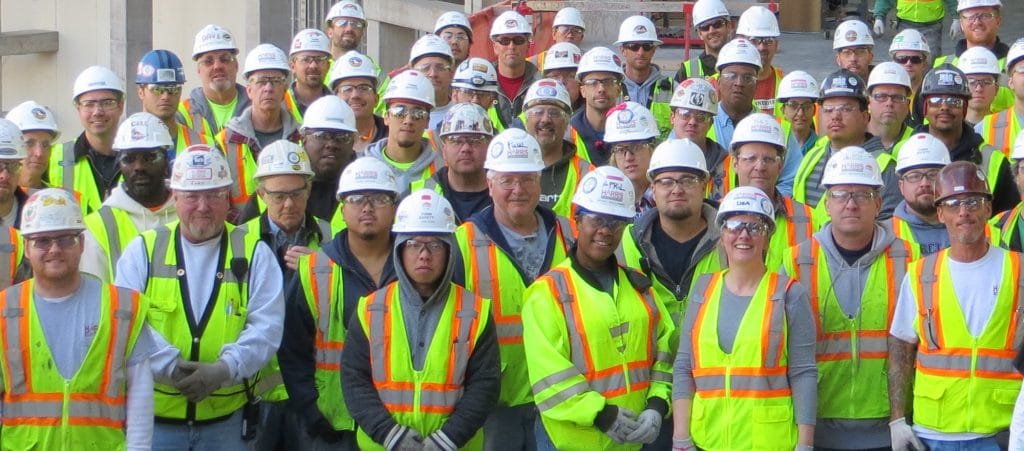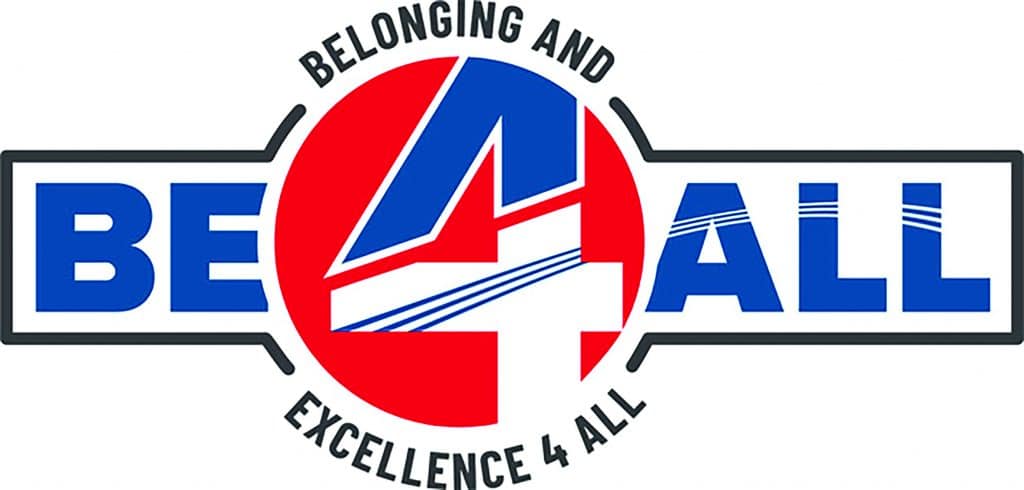
In December of last year, SMART, SMACNA and the International Training Institute (ITI) launched the Belonging and Excellence for All Campaign (BE 4 ALL).
We know that many of you have questions about this work, so we’ve taken the time to share a few answers.
Think of this article as a formal introduction. Brothers, sisters and siblings, please welcome BE 4 ALL.
1. What is BE 4 ALL?
BE 4 ALL is a joint effort of SMACNA, SMART and the ITI. The vision for the work is twofold:
A. To create a diverse and inclusive unionized sheet metal industry that is welcoming and fosters belonging for ALL people; and
B. To sustain a thriving industry in which:
- We recruit, train and retain the best talent; and
- Workers and contractors strive to achieve the highest standards of performance and excellence in their technical skills and crafts.
2. The term “belonging” is new to me. What does it mean? And how is it different from diversity and inclusion?
Here’s a helpful way to think about the difference between the three terms:
A. Diversity means that everyone – regardless of their race, gender identity, age or other identity strands — is invited to participate in and benefit from our industry.
B. Inclusion means that everyone has a seat at the table and a way to make their voices heard
C. Belonging goes much deeper than diversity and inclusion. It means two things:
- That when people come to the table, they feel that they can bring their full, authentic self – ALL parts of who they are as a human being; and
- Belonging is also about building the table together. It’s about co-creation. To put it another way, transforming our industry and ensuring that we remain relevant and competitive will take all-hands-on-deck. We will only be successful if we’re working on this endeavor TOGETHER. BE 4 ALL is the vehicle for how we do this.

3. BE 4 ALL is a fancy name. It sounds good on paper. What exactly will the initiative do on a day-to-day basis?
For 2022–23, we have a four-part agenda for our work. The four parts are as follows:
A. Assessment — Survey and interview members and leaders across the industry to better understand their hopes, wants, needs and fears related to the BE 4 ALL work.
B. Awareness — Conduct training sessions for International staff and JATC coordinators focused on strategies for reducing bias and increasing belonging.
C. Alignment — Work with SMART’s newly formed BE 4 ALL Committee to convert findings from the assessment process into concrete action steps, and meet quarterly with SMACNA and the ITI to explore ways to collaborate across the industry.
D. Act — Begin implementation of the action steps.
4. Is BE 4 ALL only for women and people of color? How do ALL members benefit?
Without question, BE 4 ALL is for ALL members and contractors. We believe that EVERY human being (with an emphasis on the word “every”) should experience belonging (see the definition under bullet #2), regardless of your race, gender identity, etc. But we also know that this is not currently the case for some groups. So BE 4 ALL may need to tailor and target programs and strategies to ensure that particular groups have what they need to reach the universal goal of belonging. But make no mistakes about it, BE 4 ALL is for the benefit of ALL members.<
5. Is this work about attacking white people?
The short answer is no. We’ve all heard the reports. Across our countries, meetings turning into shouting matches. People blaming and shaming each other. This is NOT what BE 4 ALL is about. Yes, the work of belonging requires us to have hard conversations sometimes. But it also requires that we treat each other with dignity, respect and compassion. It requires that we see our common humanity in other people.
6. Talk to me about results. What do we hope will be different as a result of this work?
We’re still in the planning stages. But over the next few years, we expect to begin seeing results in five key areas. They are:<
A. Expansion — Expanding and diversifying the pool of people from which we recruit.
B. Recruitment — Proactively recruiting new members into our organizations.
C. Training — Equipping members with the skills, tools and values they need to be successful.
D. Retention — Creating the type of work and business environments where people want to stay — and where they can imagine a long career of service and contribution.
E. Advancement — Helping members climb the ladder into leadership positions or other opportunities.
7. How long will it take for BE 4 ALL to achieve its goals?
BE 4 ALL is not a quick fix project. As one person recently put it, this is “forever work.” That said, to truly transform an entire industry will take years. However, we plan to set annual benchmarks to ensure that we’re making progress along the way. Stay tuned for our plan for 2022–23, which will include measurable goals.
8. What’s the structure of BE 4 ALL? How is it organized?
BE 4 ALL is guided by a diverse committee of members and leaders from throughout SMART, including apprentices, journey-level members and union officials. The committee makes recommendations to General President Sellers and General Secretary Treasurer Powell.
SMACNA has a similar structure.
The leadership and committees for both SMACNA and SMART, along with the ITI, meet quarterly to plan and coordinate BE 4 ALL activities across the industry.
9. Is this work about “lowering standards” or hiring people who are “unqualified?”
Absolutely not. At the recent Partners In Progress (PINP) Conference in Las Vegas, Nevada, Tim Carter, Northwest Regional Council president, and Julie Mueller, executive director for SMACNA’s Western Region, shared that they’ve seen a “dramatic reduction” in the apprentice wash out rates for women and people of color. They reported that they achieved this by “raising the bar,” not lowering it. Specifically, they improved the quality of training and support provided to apprentices to ensure that each person had what they needed to perform at the highest standards of excellence. Their approach reinforced two things: a) this work is NOT about lowering standards; and b) the work of belonging does not view people as inadequate or deficient. It sees talent and potential in all human beings. And it’s our job to nurture it.
10. Why are we even focused on this work? Can’t we just treat each other like human beings?
This is an excellent question. Yes, in the long term, the goal is to build workplaces (and a society) where we celebrate our shared humanity and where we appreciate ALL the ways that human beings are diverse or different. But in order to reach this goal, we have to remove the barriers that get in the way. These include the biases and stereotypes about each other that we’ve ALL internalized (oftentimes unconsciously) over the course of our lives. These biases and stereotypes may stem from the places where we grew up. Or the schools we attended. Or the families in which we were raised. So yes, getting to the point where we treat each other like human beings is the ultimate goal. BE 4 ALL is the pathway for how we get there.
11. If I want to get involved or support the work of BE 4 ALL, how do I do that?
If you want to learn more about BE 4 ALL, or if you’re looking to get involved, please reach out to Donna Silverman, assistant to the general president, at dsilverman@smart-union.org.
Related News
- Special Focus: SMART sisters “Let the Good Jobs Roll” at Tradeswomen Build Nations 2024
- Time to stand united
- Solidarity now, solidarity forever
- A united front
- Canadian Affairs Update: Jack Wall named new director
- Amtrak pays tribute to fallen workers
- Local 55 member details union pride for BE4ALL challenge
- Local 18 retiree wins Union Plus award
- Apprentices display union craftsmanship during 51st Ontario Sheet Metal Workers Apprenticeship Competition
- Stand against rhetoric designed to divide workers